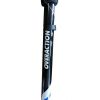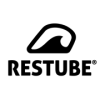Lifespan Of Your Climbing Gear – Part B Metal Components

WHEN TO RETIRE YOUR METAL EQUIPMENT
(CARABINERS, QUICKDRAWS, DESCENDERS - BELAY DEVICES, etc.)
How long your climbing gear can last depends on a wide variety of different factors.
The type of equipment (metal or textile), the quality of its materials, the frequency of use, its care and storage as well as the environment in which it is used affect its durability and lifespan.
The table below details the expected and maximum life expectancy for climbing equipment with moderate use (about twice a week):
|
Climbing Gear |
Life Expextancy |
Maximum Lifespan |
|
Harness |
2 to 3 years |
10 years |
|
Rope |
2 to 3 years |
10 years |
|
Helmet |
10 years |
10 years |
|
Quickdraws |
3 to 5 years |
10 years |
|
Belay Devices |
5 to 10 years |
N/A |
|
Carabiner |
10 to 15 years |
N/A |
Source: https://rockclimbingguru.com/how-long-climbing-gear-lasts-helpful-guidelines/
In a previous article (link) we analyzed the lifespan of textile climbing equipment (harnesses, ropes, slings). In this article we will focus on the metal parts of our equipment, carabiners, belay devices, nuts, friends, etc.
Although metallic, our materials are not immortal, mainly due to the hardship they are subjected to during their use, as well as due to a lack of proper maintenance and storage.
When to retire a carabiner
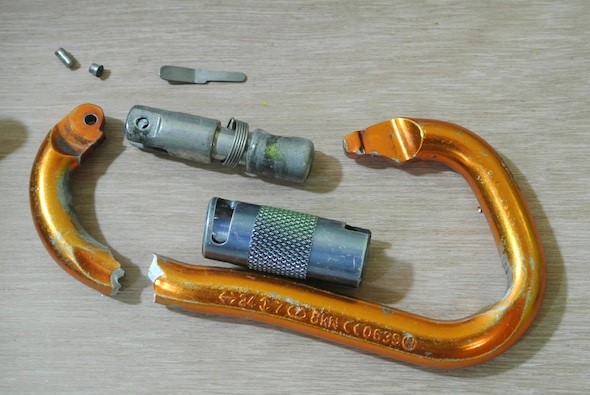
Immediately retire a carabiner if it is cracked, excessively worn, or has a malfunctioning gate.
Important: A carabiner that has been dropped from a great height should also be removed as drops can cause damage but carabiners may appear intact!
How to check your carabiners
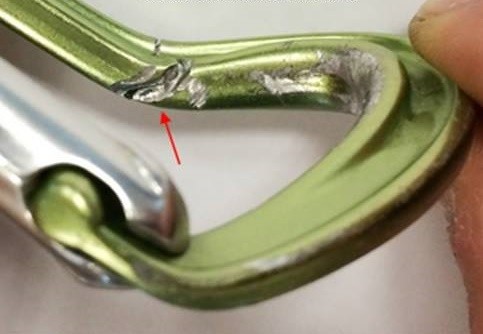
Immediately retire a carabiner if it is cracked, excessively worn, or has a malfunctioning gate.
Important: A carabiner that has been dropped from a great height should also be removed as drops can cause damage but carabiners may appear intact!
How to check your carabiners
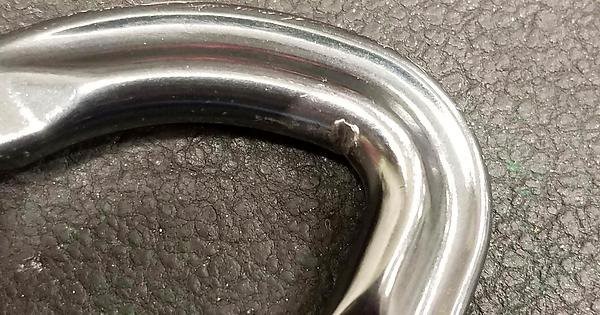
Quickdraws
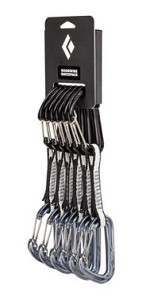
Quickdraws are a unique piece of equipment as they consist of special straps (dogbones) and carabiners. Dogbones belong to textile equipment, while carabiners are metal. Therefore, their individual parts usually last for different periods of time.
Dogbones typically last between 3 and 5 years of moderate use and have a shelf life of 10 years. Carabiners typically last 10 to 15 years of moderate use and have no limit when left unused.
Therefore, quickdraws as a whole will typically last 3 to 5 years of moderate use if the dogbone is not replaced. Replacing the dogbone every 3 to 5 years will extend the life of the quickdraws until the carabiners wear out.
Belay Devices and Descenders
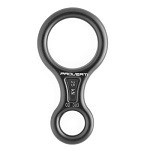
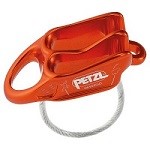
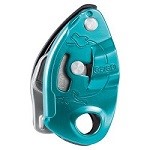
The descenders and belay devices (8s, buckets, reverso, grigri etc.) are a metal piece of climbing equipment and therefore do not have a lifetime in themselves. So they will wear out with use and at some point need to be replaced. It's another piece of climbing that should be checked before each use, as a single sharp edge can lead to irreparable damage to your rope with all the dangers that entails.
On average, belay devices will last 5 to 10 years with moderate use. If used daily they should usually be replaced within 3 years due to excessive wear.
In general, belay devices and descenders should be replaced as soon as they are damaged such as if:
- They have sharp edges
- Fall from a height of 3-4 meters or more
- Have obvious dents or cracks
As with some of the other pieces of climbing equipment, if you have any doubts about the integrity of a belay device, don't use it. Unlike other pieces of important climbing equipment, belay devices are relatively inexpensive and can be easily replaced. This gives you absolutely no reason to use a worn and bad belay device!
Nuts / Stoppers
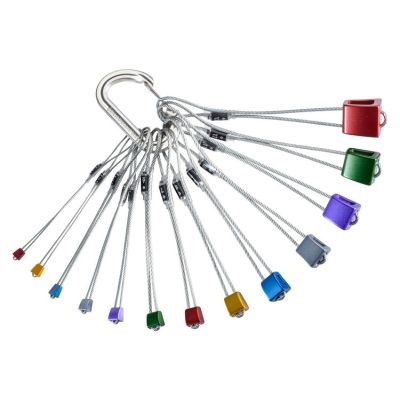
Nuts/stoppers, being metal, also do not have a shelf life limit, so their lifespan again depends on use. Specifically in this type of equipment, the most common forms of failure affect the wire rope. Careless removal of the nuts can gradually damage the wire threads. If the wire has started to wear out it is good to retire them. A permanently kinked cable is weakened and should also be retired.
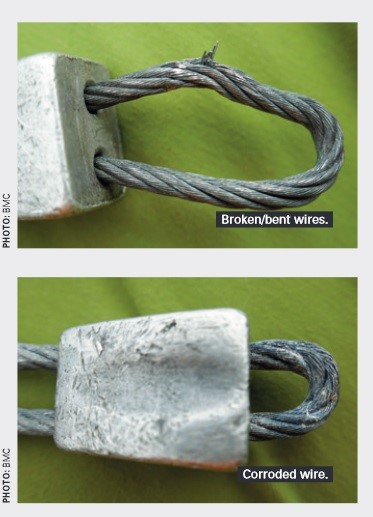
Corrosion damage is another common problem. Always wash your gear in clean water and then dry it thoroughly before storing it after climbing sea cliffs or near shore.
Damage to the nut head is more rare, but can occur as a result of a heavy drop or even overuse of a nut removal tool. Withdraw if there is much damage or distortion. Shallow/superficial scratches are usually not a problem.
Friends
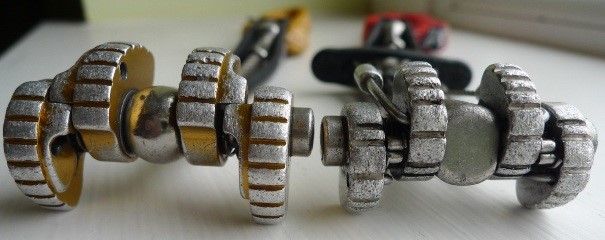
Another important and special part of the climbing equipment (which also concerns traditional "trad" and not sport climbing) is "friends".
Although friends are designed with great precision and expertise today, they are subject to failure due to wear and bending fatigue. This occurs at the point where the flexible member (wire rope) joins the rigid member due to repeated bending.

It is therefore important to carefully examine this particular point and if it is found that some strands of the flexible stem are broken, then it is definitely time to withdraw the device!
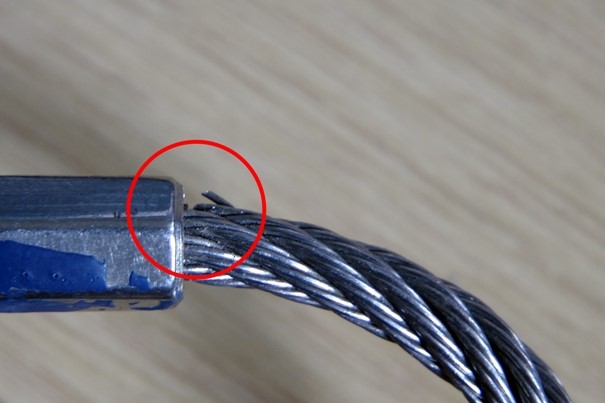
In most modern friends, the potential break point is often covered by a protective plastic casing, and in some cases this casing can be moved slightly to allow inspection.
A thorough inspection of the friends at the beginning of the climbing season is therefore recommended in conjunction with the inspection before or after each use!
Storage of metal equipment
Do not store carabiners, descenders, belay devices, quickdraws, etc. in humid or salty air, along with wet equipment or clothing, or near corrosive chemicals. Proper storage and maintenance will protect your equipment as much as possible!
Sources
https://thebmc.co.uk/have-you-checked-your-camming-devices-recently
https://www.rei.com/learn/expert-advice/when-to-retire-climbing-gear.html
https://www.rei.com/learn/expert-advice/caring-for-your-carabiners.html
https://rockclimbingguru.com/how-long-climbing-gear-lasts-helpful-guidelines/
https://goextremesports.com/how-long-does-a-grigri-last/
Recent posts
-
24/05/2024Backpack Guide Part Α’ 10 – 30 L
-
20/03/2024Guide for crampons
-
19/02/2024Hangboarding for beginners
-
06/02/2024Rock Climbing in Occupational Therapy
-
23/11/2023Climbing Grades
-
22/11/2023Climbing in psychotherapy
-
16/11/2023What is Bouldering
-
15/11/2023Trad VS Sport Climbing
-
15/11/2023Winter Tents
-
07/11/20233 Season Tents
-
03/11/2023Summer Tents
-
02/11/2023Lifespan Of Your Climbing Gear – Part B Metal Components
-
02/11/2023Lifespan Of Your Climbing Gear – Part A (Harness, Rope, Slings and Webbing)
-
30/10/2023Nail Vernis Aquaglutene - Vade Retro
-
30/10/2023THE LOG BOOK
-
30/10/2023Mountain cookware
-
30/10/2023Our Blog
-
30/10/2023Climbing Shoes - Quick Buying Guide
-
30/10/2023Washing and maintenance of the sleeping bag
-
30/10/2023Superlight Tents
-
30/10/2023ΙNFORMATION FOR CRAMPONS
-
30/10/2023Ice axe
-
30/10/2023INFLATABLE MATTRESS SLEEP
-
30/10/2023Nikwax secrets of waterproofing
-
30/10/2023What Is “Softshell”?
-
30/10/2023Slacklining, ένας εναλλακτικός τρόπος γυμναστικής.
-
30/10/2023Mountaineering - Hiking Boots
-
30/10/2023Waterproof Membranes
-
30/10/2023Sleeping Bags
-
30/10/2023Sleeping Mats
-
30/10/2023Base Layers
-
30/10/2023Climbing Helmets






















































































































